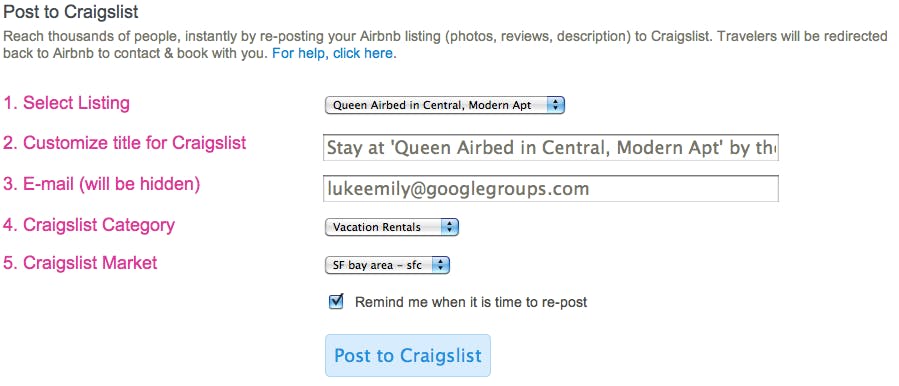How to find the best marketplace growth strategies
Choosing the early-stage marketing mix for your marketplace.
Published on
Last updated on

In this chapter of the How to create a marketplace guide, we help you find the right marketplace growth strategies. Also available as a podcast.
After you have seeded your marketplace with a stable initial user base, it's time to start thinking about growth. Here's how to find the right growth channel for your early-stage marketplace.
As Boris Wertz and Angela Tran explain in their marketplace handbook, the key to growing a marketplace is to reach a virtuous cycle: high-quality providers bring in more customers, and the growing customer base, in turn, attracts more providers. In this chapter, we will discuss how to attain this cycle.
Before we dive into growth tactics, we first need to talk about growth itself. Understanding what kind of growth to expect is important to set realistic expectations. In general, building marketplace businesses takes more time than other online businesses. Wertz and Tran urge marketplace founders to be patient:
– With a typical SaaS or e-commerce startup, you probably should reassess your market or model if you don't see signs of traction after six to nine months. However, this timetable is way too accelerated for marketplaces. Considering you need to establish both buyer and seller communities, you will need more time to prove your business. It can take three years for a marketplace to get going.
As startup guru Paul Graham writes, the most common reason startup companies die is a loss of faith in their business. This is especially common for marketplaces, where it may seem like the business is not going anywhere for a long time. It took four years before Airbnb really took off.
Don't be one of the founders who give up too soon. Be patient. Constantly try new things, but don't give up. You'll get there eventually.
Growing too fast may actually kill a marketplace business. As Andrei Hagiu and Simon Rothman write in their excellent essay, Network Effects Aren't Enough: "Growing too early amplifies flaws in the business model, making them harder to fix." Figuring out the optimal revenue stream that extracts enough value—but not too much—from your transactions can only be done through trial and error. If you scale too fast without finding this optimal model, it can lead to a breakdown of your business.
However, things should consistently be moving forward. You should see some sort of improvement every month: more provider signups, more transactions, improved liquidity. If this is not happening despite your continuous efforts, changes need to be made. This is where growth tactics come in.
Multiple growth strategies exist for all types of marketplaces. The key is to test different channels quickly, figure out which ones work, and focus on those.
Gabriel Weinberg and Justin Mares provide a useful framework for this process in their book Traction: How Any Startup Can Achieve Explosive Customer Growth. The framework is called Bullseye and is shown in the image below. It is based on a simple method:
- Start by brainstorming potential growth ideas.
- Select the most promising ones, and perform quick tests with each, all in parallel. Each test should last no more than a month.
- Once the tests are done, select the channel that worked the best and focus on it until it no longer "moves the needle".

For a channel to "move the needle", it should be moving you closer to your growth target at a fast-enough pace. Different channels work well at different stages. One channel can be perfect for reaching 1,000 monthly transactions but might not help when your goal is to reach 100,000 transactions per month. When a channel is no longer moving the needle, you need to find a new channel.
Weinberg and Mares identified the 19 most common channels that any business can use to get traction. You may notice that there is also a lot of overlap between the channels, and they often work best when combined together. We will only cover the channels that are most commonly used by successful marketplaces in this chapter, but it is a good idea to keep all of them in mind if you come up with ways to leverage them.
Viral marketing means growing your user base by encouraging your users to bring in new customers. It is a key acquisition channel for many marketplaces since it is a requirement for the virtuous cycle that Wertz and Tran talk about. It is also a scalable method—the effect increases as your user base grows without requiring more work from you. To make your marketplace viral, you need to give your users an incentive to invite others on board. The best incentive depends on the nature of your marketplace.
In many cases, an online marketplace may be the first time a professional provider gets an online presence. In these situations, educating providers on how to market their offering outside your marketplace is a solid strategy. After all, helping your providers find customers is great not just for them but for the marketplace as well. As an example, Etsy created a seller handbook that offers great advice on how to do marketing. In an ideal scenario, your providers become your marketing team.
Customers do not have similar intrinsic incentives to bring on other customers, which is why you need to create an incentive. A common way to create a "viral loop" is to offer monetary compensation for referrals. Airbnb uses this strategy: they offer discounts for customers that bring new guests and hosts onboard.
It is also possible to combine these two viral strategies (discounts and marketing tools). For example, Udemy allows instructors to keep a bigger portion of each sale if they handle the promotion of their courses themselves.
Search engine optimization (SEO) is the process of improving your rank in search engines to help more people find your site. Instead of promoting yourself actively to potential customers, you make yourself easy to find for those who are looking for the products or services on your marketplace.
Some SEO work also lies on the shoulders of your providers. The key is—again—to educate them about best practices. Etsy does a great job here as well, offering a comprehensive guide for its sellers on how to get found.
There are certain things that a marketplace can and should do to help with SEO. Tradesy, a marketplace for pre-owned high-quality fashion, gets a significant amount of sales from unpaid search traffic, largely because it has structured its listings in a way that makes it easy for search engines to crawl the marketplace. Course Hero, a marketplace for study resources, uses a similar strategy effectively.
Marketplaces are some of the most challenging websites to optimize for search engines. The good news is that the opportunities are therefore also more substantial. If you think SEO could be a growth lever for your business, read our complete guide to marketplace SEO to get started. Moz's The Beginner's Guide to SEO is a great resource as well.
Marketplace content marketing is a good way to build your initial customer base. Your content can also be used to help you grow in three ways.
First, it improves your search engine ranking (as discussed in the previous section). People will stumble across your content when they search for your marketplace's niche, through which they will discover your marketplace.
Second, quality content gets shared on social media. If you manage to create an engaging piece of content, it might be seen by millions of readers with little or no promotion. However, you shouldn't rely too much on this effect as it takes a great deal of luck to create such a phenomenon.
Third, your content can help your providers improve their offerings. Etsy's Seller handbook, which we discussed above, is a great example of content marketing. It helps Etsy sellers sell more effectively, but new sellers also discover Etsy directly through the handbook.
If you have capital at your disposal, it can be used to buy growth. The most common way to do it is through Search Engine Marketing, i.e., displaying ads on Google or other search engines based on the search keywords. Social Media Marketing (promoted content on sites like Facebook and Twitter) or banner ads are other popular forms of paid advertising.
The challenge with paid ads is that you need to be sure the return on your investment is positive. You need to get back more money than you spend on ads. With marketplaces, calculating the return is tricky since you cannot really be sure how much a user is worth. A new user may become a provider that generates thousands of transactions, or they may never participate in a single transaction.
Another challenge for paid marketing is competition. Since ads are generally bought auction-style—with companies bidding for placement—advertising for popular search terms on Google can become very expensive. A good way to circumvent this is to try to find keywords that have a relatively large search volume but are not being advertised on. Google also gives a "discount" for ads that are relevant to whatever is being searched for. Having high-quality content and good SEO can pay off in the form of reduced ad prices.
In most cases, paid ads are unsuitable as the main acquisition channel for early-stage marketplaces due to cost. The situation may be different if you have deep pockets and are in a "winner takes it all" market where you need to grab market share before your competitors. Uber executed this strategy effectively in many cities—but only after they had perfected their base offering.
However, this does not mean early-stage marketplaces should not take advantage of paid ads. They can be very useful in testing out marketing angles. For instance, if you believe you should focus your SEO and content marketing efforts on people who perform certain types of queries in Google, running a Google Ads campaign is an easy way to test whether you should pay for the top position for certain keywords. You will see quickly how large the search volume is, how much ads cost, and how large a portion of people who click on your ad actually end up making a purchase.
There's a statistic that says, on average, attracting new customers costs five times as much as keeping an existing customer. Marketplaces generally spend too much time acquiring new users instead of activating existing ones.
In the previous chapter, we discussed the importance of building an email list early on for your marketplace launch. This work should be continued after you launch as well. Email is the most efficient way to reach your existing users and activate them on your marketplace. The list should be used actively to send your users offers, lists of interesting new products or services on your marketplace, useful articles from your blog, and so on.
Etsy has done a great job keeping the people who make their first purchase active on the site. From the graph below, you can see that a whopping 78 percent of its sales in 2014 came from repeat customers. This is quite likely a key reason why Etsy requires every buyer to become a user.

A good way to use the email list is to tell the stories of your successful customers. This strategy of creating social proof is vital in creating the virtuous cycle: as soon as someone is making a profit on your marketplace, others will become interested and more active, increasing the number of success stories. Udemy used this strategy heavily as soon as their instructors started making serious money.
Many successful modern marketplaces succeed by building active communities around their offering. Airbnb specifically refers to itself as a community marketplace. Meanwhile, Etsy proclaims to be "more than a marketplace: we're a community." Both platforms want their users to engage with each other and spend time on their site—even when they do not intend on buying anything. This is often a smart move since it builds retention: if your users feel like they are part of a community, they are less likely to jump ship to other marketplaces. Check out this article for more tactics for marketplace community-building.
Sometimes the best way to grow is to build new growth-oriented functionality into your product. The term "growth hacker", which is often used to describe digital marketers in general, was originally coined by growth specialist Andrew Chen—who is currently heading supply growth at Uber—to mean a marketer that uses technical skills to foster growth.
As a case example, Chen used Airbnb's Craigslist integration. We'll discuss it in more detail in the next section, where we look closely at how Airbnb used different channels at different phases of their growth.
Airbnb's growth story has been well documented by Morgan Brown in a GrowthHackers.com case study. We encourage you to read it entirely but will recap the essentials here.
In 2009, during Airbnb's early stages, they began by doing things that did not scale. The founders went to stay at a bunch of Airbnb apartments themselves to figure out why they were not getting more bookings. They identified low-quality photographs as the culprit and decided to invest time and money in taking better photos. This boosted initial growth.
The next bottleneck was supply. To combat that, Airbnb used email marketing and contacted people who were listing their apartments on Craigslist to explain the benefits of Airbnb. They used a rather sketchy and spammy strategy for this, which we do not recommend. Instead of using fake emails, they could have simply sent the same emails from their own accounts. Nevertheless, it helped them get enough supply to reach the next level.
After getting more suppliers on board, the bottleneck switched back to demand. For this, they again turned to Craigslist, which had many potential customers visiting it every day. This time, they turned things around: instead of convincing Craigslist users to advertise their property on Airbnb, they urged hosts to post Airbnb ads on Craigslist. This was engineering as marketing. They built an integration that made it easy to advertise an Airbnb listing on Craigslist directly from Airbnb's user interface. Andrew Chen explains how the process worked.

At some point, Airbnb had exhausted Craigslist as a channel. They needed to build the viral engine that would feed itself. On average, each existing user should bring in more than one new user. To do that, they built a carefully designed referral program that created incentives for people to invite their friends. This process is documented in detail in the Airbnb Nerds blog. With this setup in place, Airbnb managed to create the virtuous cycle Wertz and Tran talk about.
During the early stages of a marketplace, it is vital to focus on a narrow niche. However, if things go well, at some point, you may capture such a large share of your initial niche market that there is no longer room to grow. At that point, you need to start thinking about scaling beyond your initial focus.
Boris Wertz describes three strategies for moving from the niche to the masses. The most obvious one is to add more categories. This worked well for Amazon, which started with just books, but today offers all types of products. Similarly, eBay started by focusing on specific categories, like Beanie Babies, before gradually expanding.
A good sign that it is time to expand is when you start seeing many items on your marketplace that do not have their own category. This is how Etsy expanded to crafting supplies.
Another strategy is to start catering to new audiences. Perhaps your platform first focuses only on university students, as Facebook did, and later expands to other demographics as well.
The third option is to keep the same focus but expand the size of the market itself. As Wertz explains, this worked well for Lululemon and Etsy: yoga is way bigger today than it was ten years ago, and the maker movement and enthusiasm towards arts & crafts have seen similar explosive growth. As an example of how to expand a market, Etsy started to educate aspiring entrepreneurs on how to become crafts sellers.
As you scale, you will face new types of problems. Umang Dua and Oisin Hanrahan started Handy as a marketplace for home cleaning services and later expanded to other local service categories. They write about their scaling process and how the challenges they face have changed tremendously. The main issue with scaling is that while in the early days you can fix problems as they arise, putting out fires is no longer enough when you grow. You need to fix the underlying causes instead.
How can you deal with this challenge? How do you know which problems to prioritize? As Dua and Hanrahan recommend:
– The base level of the pyramid starts with trust — without trust, nothing else matters. If your customers don't trust you, they won't use your service…
Building trust in your marketplace and user community is important for most platforms to achieve true scale.
Let's jump back to our fictional personal trainer marketplace from previous chapters and put what we have learned into practice.
You already created a blog as part of your launch strategy, and content marketing combined with email updates about new offers remains at the core of your marketing.
Your blog also improves your search engine ranking. You continue researching the most important keywords and write about those topics on your blog. After a while, these new blog posts bring you free visibility for those search terms. You remember to direct blog readers directly to your marketplace. You test the impact of the best keywords with quick Google AdWords campaigns.
You decide to create a guide for your trainers on how to advertise their services online. It includes advice on how to create high-quality photos and videos, how to optimize their profile for search engines, and even how to buy paid ads. This allows you to outsource part of your marketing efforts to the trainers.
You approach all your trainers regularly to remind them to invite their customers to the marketplace. It makes sense for the trainers since your platform helps them with invoicing and scheduling. The more their customers use your site, the easier it is for the trainers. You decide to incentivize customers to invite new members with a special offer: for each new person that a customer gets on board, both the invitee and the existing customer get 50% off their next booking. This allows you to create a viral loop.
In this chapter, we discussed different strategies for growing your marketplace. While growth is important, marketplaces need more time to grow than traditional online businesses. You need to be patient and grow slowly in the beginning to validate and optimize your business.
When you are ready to scale, you should test different growth channels to find the one that works best for that growth stage and focus on it until it is exhausted. It might make sense to use multiple channels in parallel, as they can complement each other effectively. The most common marketplace growth channels are viral marketing, search engine optimization, content marketing, paid advertising, email marketing, community-building, and engineering as marketing.
At a certain stage, it may be time to scale your marketplace beyond your initial niche. This can be done by expanding your categories, your audience demographic, or the market itself. As you scale, the set of challenges you face will change, and you need to learn new ways to handle them.
Now that your marketplace is growing, how do you know whether it is successful or not?
You might also like...

Marketplace metrics: 26 key metrics and how to use them
What metrics should a marketplace founder track? And how to translate what you track into action? Here’s how to identify and track the key metrics, how to separate them from vanity metrics, and how to make concrete decisions based on reliable data.

How to grow your marketplace on a budget
The road to 1,000 customers starts with 10 happy ones (that you didn’t have to pay for).

Marketplace SEO: the complete guide
Get a comprehensive introduction to the world of SEO, tailored specifically to online marketplaces.

Brian Rothenberg at the Marketplace Conference: Driving growth via buyer/seller overlap
Trust Eventbrite’s VP of Growth: if customers are turning to providers on your marketplace, you’re on to something magical.
Start your 14-day free trial
Create a marketplace today!
- Launch quickly, without coding
- Extend infinitely
- Scale to any size
No credit card required
